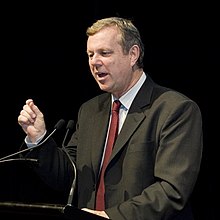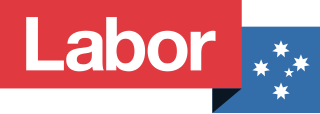
The Australian Labor Party (ALP), also known simply as Labor or the Labor Party, is the major centre-left political party in Australia and one of two major parties in Australian politics, along with the centre-right Liberal Party of Australia. The party has been in government since being elected at the 2022 federal election, and with political branches in each state and territory, they currently form government in New South Wales, Queensland, South Australia, Victoria, Western Australia, the Australian Capital Territory, and the Northern Territory. As of 2023, Tasmania is the only state or territory where Labor forms the opposition. It is the oldest continuous political party in Australian history, being established on 8 May 1901 at Parliament House, Melbourne, the meeting place of the first federal Parliament.
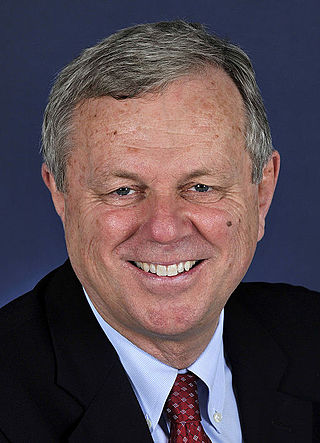
Michael David Rann,, is an Australian former politician who was the 44th premier of South Australia from 2002 to 2011. He was later Australian High Commissioner to the United Kingdom from 2013 to 2014, and Australian ambassador to Italy, Albania, Libya and San Marino from 2014 to 2016.

Martin John Ferguson is an Australian former Labor Party politician who was the Member of the House of Representatives for Batman from 1996 to 2013. He served as Minister for Resources and Energy and Minister for Tourism in the Rudd and Gillard governments from 2007 to 2013.

Arkaroola is the common name for the Arkaroola Wilderness Sanctuary, a wildlife sanctuary situated on 610 square kilometres of freehold and pastoral lease land in South Australia. It is located 700 kilometres north of the Adelaide city centre in the Northern Flinders Ranges, adjacent to the Vulkathunha-Gammon Ranges National Park and the Mawson Plateau. The most common way to get there is by car, but air travel can be chartered from Parafield Airport, Adelaide Airport or Aldinga Airfield. It was used as a location set for the 2002 film The Tracker.
Michael Jerome Young was an Australian politician. He rose through the Australian Labor Party (ALP) to become its National Secretary, before serving as a Labor member of the House of Representatives from the 1974 election to 1988. He was a senior minister in the Hawke government, and was a prominent political figure during the 1970s and 1980s. Young was also President of the Australian Labor Party from 1986 to 1988.
The following lists events that happened during 1977 in Australia.
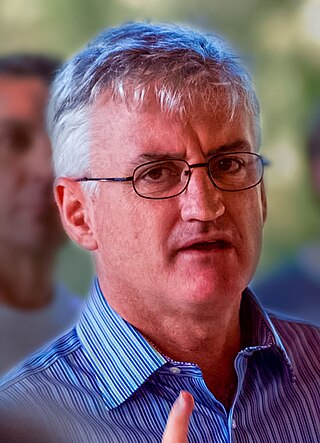
Alan John Carpenter is a former Australian politician who served as the 28th Premier of Western Australia, from 2006 to 2008. From Albany, Carpenter graduated from the University of Western Australia, and worked as a journalist before entering politics. A member of the Labor Party, he was first elected to the Legislative Assembly at the 1996 state election, representing the seat of Willagee. In the Gallop ministry, which took office following the 2001 election, Carpenter was Minister for Education, as well as holding several other portfolios. He replaced Geoff Gallop as premier in January 2006, following Gallop's resignation, but Labor lost office following a hung parliament at the 2008 election, with Colin Barnett becoming premier as the leader of a minority Liberal Party government. Carpenter resigned from parliament in 2009, and until 2018 held a senior management position with Wesfarmers.
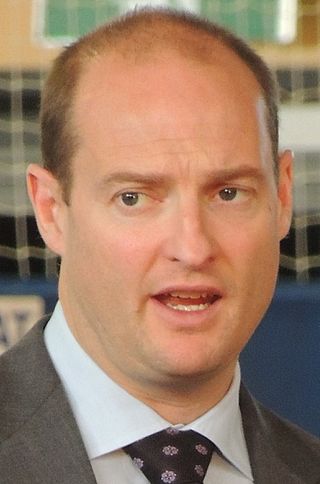
Thomas Richard Kenyon is a former Australian politician who represented the South Australian House of Assembly seat of Newland for the Labor Party from the 2006 election until his defeat in 2018. Kenyon left the Labor Party in 2021 to found the Family First Party.
Shelley Frances Archer is a former Australian politician. She was a Labor Party member of the Western Australian Legislative Council from May 2005, representing the Mining and Pastoral electoral region. A former union official, she was one of several state MPs to become involved in the 2006–2007 Corruption and Crime Commission investigation into the dealings of former-Premier-turned-lobbyist Brian Burke. The partner of influential unionist Kevin Reynolds, she was associated with the conservative wing of the party.

Nuclear weapons testing, uranium mining and export, and nuclear power have often been the subject of public debate in Australia, and the anti-nuclear movement in Australia has a long history. Its origins date back to the 1972–1973 debate over French nuclear testing in the Pacific and the 1976–1977 debate about uranium mining in Australia.

Nuclear power in Australia has been a topic of debate since the 1950s. Australia has one nuclear reactor in Lucas Heights, New South Wales, although it is only used to produce radioisotopes for nuclear medicine, and does not produce electricity. Australia hosts 33% of the world's proven uranium deposits, and is currently the world’s third largest producer of uranium after Kazakhstan and Canada.

The Hawke government was the federal executive government of Australia led by Prime Minister Bob Hawke of the Australian Labor Party (ALP) from 1983 to 1991. The government followed the Liberal-National Coalition Fraser government and was succeeded by another Labor administration, the Keating government, led by Paul Keating after an internal party leadership challenge in 1991. Keating was Treasurer through much of Hawke's term as prime minister and the period is sometimes termed the Hawke-Keating government.

The Beverley Mine is Australia's third uranium mine and Australia's first operating in-situ recovery mine. It is located in South Australia in the gazetted locality of Wooltana about 35 km from Lake Frome at the northern end of the Flinders Ranges. It officially opened in 2001. The original Beverley uranium deposit was discovered by one of Bill Siller's companies in 1969 and was named after his wife—Beverley Siller.
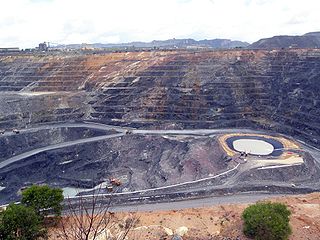
Radioactive ores were first extracted in South Australia at Radium Hill in 1906 and Mount Painter in 1911. 2,000 tons of ore were treated to recover radium for medical use. Several hundred kilograms of uranium were also produced for use in ceramic glazes.
Four Mile is Australia's fifth uranium mine. It is sited in the Frome Basin in far north of the state of South Australia, around 600 kilometres (370 mi) north of the state capital, Adelaide. It is 10 kilometres (6 mi) from the existing Beverley uranium mine, where its uranium oxide product is produced. Construction of the mine commenced in late 2013 and the mine was officially opened in June 2014.
Lake Way is a dry saline lake located in the Mid West region of Western Australia, approximately 15 kilometres (9.3 mi) south of Wiluna. It also gives its name to a nearby cattle station, the Lake Way Station.
The Yeelirrie uranium project is a uranium deposit located approximately 70 km southwest of Wiluna, in the Mid West region of Western Australia. The name Yeelirrie is taken from the local sheep station.

The Olympic Dam mine is a large poly-metallic underground mine located in South Australia, 550 km (340 mi) NNW of Adelaide. It is the fourth largest copper deposit and the largest known single deposit of uranium in the world. Copper is the largest contributor to total revenue, accounting for approximately 70% of the mine's revenue, with the remaining 25% from uranium, and around 5% from silver and gold. BHP has owned and operated the mine since 2005. The mine was previously owned by Western Mining Corporation. Since the 1970s environmentalists, traditional owners and others have campaigned against the mine, largely on the basis of its contribution to the nuclear cycle and its use of underground water.

The Rann government was the state executive government of South Australia led by Premier of South Australia Mike Rann of the South Australian Branch of the Australian Labor Party (ALP) from 2002 to 2011.
The Australian Labor Party National Conference, sometimes referred to as the National Party Conference or the Federal Conference, is the highest representative and decision-making body of the Australian Labor Party, incorporating all of the party’s state and territory branches. The National Conference takes place triennially and is hosted in Australian cities on a rotating basis. The 49th and most recent National Party Conference was held on the 17th to the 19th of August 2023 at the Brisbane Convention and Exhibition Centre and was attended by over 2,000 delegates.
